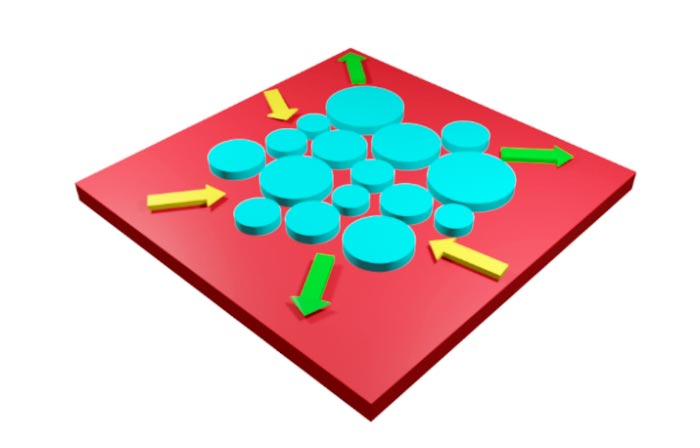Physicists develop a linear response theory for open systems having exceptional points

The linear response theory developed in this work provides a full characterization of the relation between output and input signals (indicated by green and yellow arrows, respectively) in terms of the eigenmodes and the canonical states of the underlying non-Hermitian Hamiltonian.
Credit: Ramy El-Ganainy
Linear analysis plays a central role in science and engineering. Even when dealing with nonlinear systems, understanding the linear response is often crucial for gaining insight into the underlying complex dynamics. In recent years, there has been a great interest in studying open systems that exchange energy with a surrounding reservoir. In particular, it has been demonstrated that open systems whose spectra exhibit non-Hermitian singularities called exceptional points can demonstrate a host of intriguing effects with potential applications in building new lasers and sensors.
At an exceptional point, two or modes become exactly identical. To better understand this, let us consider how drums produce sound. The membrane of the drum is fixed along its perimeter but free to vibrate in the middle. As a result, the membrane can move in different ways, each of which is called a mode and exhibits a different sound frequency. When two different modes oscillate at the same frequency, they are called degenerate. Exceptional points are very peculiar degeneracies in the sense that not only the frequencies of the modes are identical but also the oscillations themselves. These points can exist only in open, non-Hermitian systems with no analog in closed, Hermitian systems.
Over the past years, ad-hoc analysis of the scattering coefficients of non-Hermitian systems having exceptional points has revealed a puzzling result. Sometimes, their frequency response (the relation between an output and input signals after interacting with the system as a function of the input signal’s frequency) can be Lorentzian or super Lorentzian (i.e. a Lorentzian raised to an integer power). In contrast, the response of a standard linear, isolated oscillator (excluding situations where Fano lineshapes can arise) is always Lorentzian.
An international team of physicists led by Ramy El-Ganainy, associate professor at Michigan Technological University, tackled this problem in their recent Nature Communications article titled “Linear response theory of open systems with exceptional points.” The team presents a systematic analysis of the linear response of non-Hermitian systems having exceptional points. Importantly, they derive a closed-form expression for the resolvent operator quantifying the system’s response in terms of the right and left eigenvectors and Jordan canonical vectors associated with the underlying Hamiltonian.
“In contrast to previous expansions of the resolvent operator in terms of the Hamiltonian itself, the formalism developed here provides direct access to the linear response of the system and demonstrates exactly when and how Lorentzian and super-Lorentzian responses arise” says Prof. El-Ganainy. “As it turned out, the nature of the response is determined by the excitation (input) and collection (output) channels” says Amin Hashemi, the first author of the manuscript. The presented theory describes this behavior in detail and is generic enough to apply to any non-Hermitian systems having any number of exceptional points of any order, which makes it instrumental for studying non-Hermitian systems with large degrees of freedom.
The paper also includes authors from Penn State, the Humboldt University in Berlin, and the University of Central Florida.
About Michigan Technological University
Michigan Technological University is a flagship technological public research university founded in 1885 in Houghton, Michigan. The University offers more than 125 undergraduate and graduate degree programs in science and technology, engineering, computing, forestry, business and economics, health professions, humanities, mathematics, social sciences, and the arts. The rural campus is situated just miles from Lake Superior in Michigan’s Upper Peninsula and is home to more than 7,000 students.
Journal: Nature Communications
DOI: 10.1038/s41467-022-30715-8
Subject of Research: Not applicable
Article Title: Linear response theory of open systems with exceptional points
Article Publication Date: 7-Jun-2022
All latest news from the category: Physics and Astronomy
This area deals with the fundamental laws and building blocks of nature and how they interact, the properties and the behavior of matter, and research into space and time and their structures.
innovations-report provides in-depth reports and articles on subjects such as astrophysics, laser technologies, nuclear, quantum, particle and solid-state physics, nanotechnologies, planetary research and findings (Mars, Venus) and developments related to the Hubble Telescope.
Newest articles

NASA: Mystery of life’s handedness deepens
The mystery of why life uses molecules with specific orientations has deepened with a NASA-funded discovery that RNA — a key molecule thought to have potentially held the instructions for…

What are the effects of historic lithium mining on water quality?
Study reveals low levels of common contaminants but high levels of other elements in waters associated with an abandoned lithium mine. Lithium ore and mining waste from a historic lithium…

Quantum-inspired design boosts efficiency of heat-to-electricity conversion
Rice engineers take unconventional route to improving thermophotovoltaic systems. Researchers at Rice University have found a new way to improve a key element of thermophotovoltaic (TPV) systems, which convert heat…



